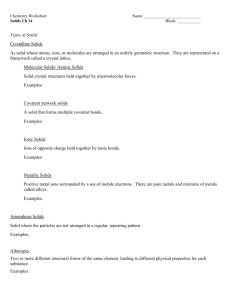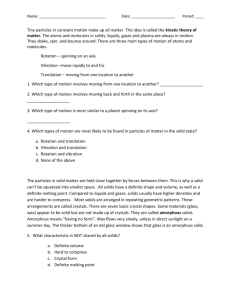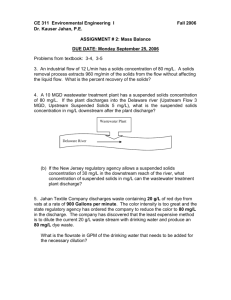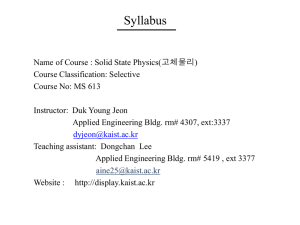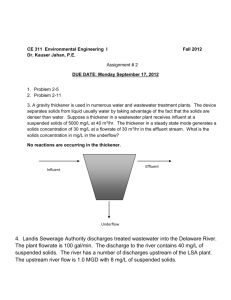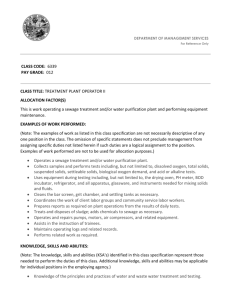correlate the density of a substance with its unit cell - e-CTLT
advertisement
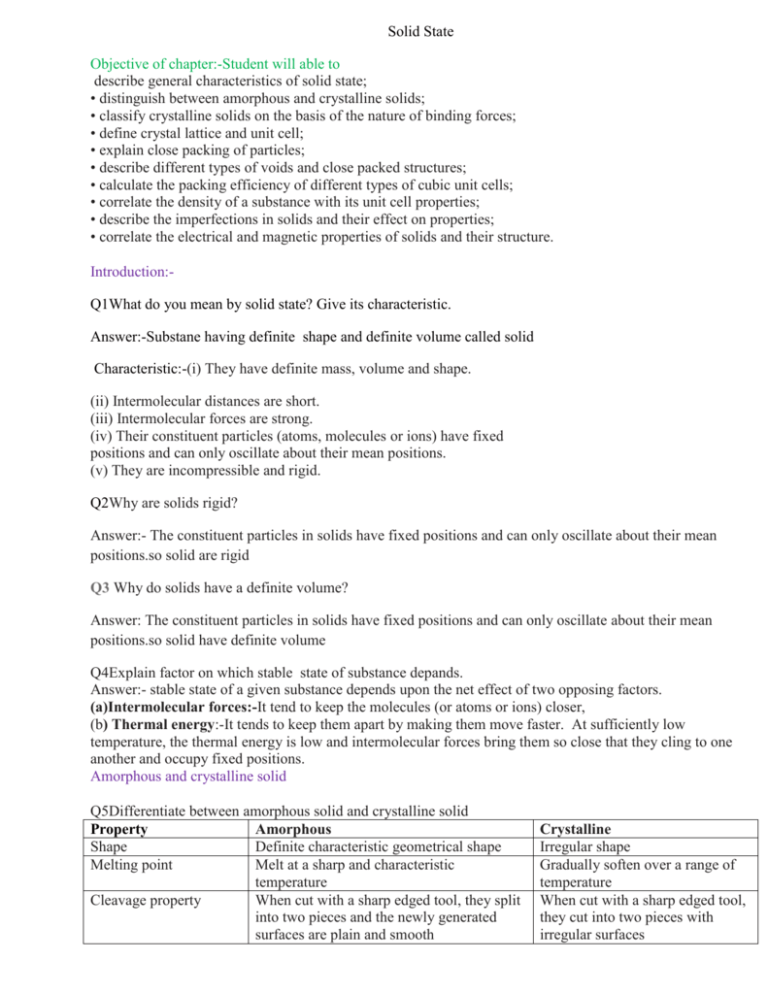
Solid State Objective of chapter:-Student will able to describe general characteristics of solid state; • distinguish between amorphous and crystalline solids; • classify crystalline solids on the basis of the nature of binding forces; • define crystal lattice and unit cell; • explain close packing of particles; • describe different types of voids and close packed structures; • calculate the packing efficiency of different types of cubic unit cells; • correlate the density of a substance with its unit cell properties; • describe the imperfections in solids and their effect on properties; • correlate the electrical and magnetic properties of solids and their structure. Introduction:Q1What do you mean by solid state? Give its characteristic. Answer:-Substane having definite shape and definite volume called solid Characteristic:-(i) They have definite mass, volume and shape. (ii) Intermolecular distances are short. (iii) Intermolecular forces are strong. (iv) Their constituent particles (atoms, molecules or ions) have fixed positions and can only oscillate about their mean positions. (v) They are incompressible and rigid. Q2Why are solids rigid? Answer:- The constituent particles in solids have fixed positions and can only oscillate about their mean positions.so solid are rigid Q3 Why do solids have a definite volume? Answer: The constituent particles in solids have fixed positions and can only oscillate about their mean positions.so solid have definite volume Q4Explain factor on which stable state of substance depands. Answer:- stable state of a given substance depends upon the net effect of two opposing factors. (a)Intermolecular forces:-It tend to keep the molecules (or atoms or ions) closer, (b) Thermal energy:-It tends to keep them apart by making them move faster. At sufficiently low temperature, the thermal energy is low and intermolecular forces bring them so close that they cling to one another and occupy fixed positions. Amorphous and crystalline solid Q5Differentiate between amorphous solid and crystalline solid Property Amorphous Shape Definite characteristic geometrical shape Melting point Melt at a sharp and characteristic temperature Cleavage property When cut with a sharp edged tool, they split into two pieces and the newly generated surfaces are plain and smooth Crystalline Irregular shape Gradually soften over a range of temperature When cut with a sharp edged tool, they cut into two pieces with irregular surfaces Heat of fusion They have a definite and characteristic Anisotropy Nature Anisotropic in nature True solids Order in arrangement of constituent particles Shape Melting point Long range order Definite characteristic geometrical shape Melt at a sharp and characteristic They do not have definite heat of fusion Isotropic in nature Pseudo solids or super cooled liquids Only short range order. Irregular shape Gradually soften over a range of temperature Q6Classify the following as amorphous or crystalline solids: Polyurethane, naphthalene, benzoic acid, teflon, potassium nitrate, cellophane, polyvinyl chloride, fibre glass, copper. Answer: Polyurethane, Teflon, cellophane, polyvinyl chloride, fibre glass – Amorphous solids Naphthalene, benzoic acid, potassium nitrate, copper – Crystalline solids. Q7Why is glass considered a super cooled liquid? Answer:-Glass is an amorphous solids, it has tendency to flow but very slowly. This is the cause that glass is considered as super cooled liquid Q8 How does amorphous silica differ from quartz? Answer:- In amorphous silica, SiO4 tetrahedral are randomly joined to each other whereas in quartz they are linked in a regular manner. Isotropic and anisotropic properties of solid Q What do you mean by isotropy and anisotropy of crystal Anisotropy:-Solid substance having different physical properties( electrical resistance, refractive index) along different axes. Crystal of NaCl, Quartz, Ice, HCl, Iron, etc. are some examples of crystalline solid. Reasion:-due to different arrangement of partical in different axis in crystalline solid Isotropy:- Solid substance having same physical properties( electrical resistance, refractive index) along different axes. Reason:-Due to not having orderly arrangement of constituent particals Q8Refractive index of a solid is observed to have the same value along all directions. Comment on the nature of this solid. Would it show cleavage property? Answer: Amorphous solids are isotropic in nature, i.e. they have short range order of arrangement of particles. Because of this amorphous solids have same value of refractive index along all directions. Amorphous solids do not show cleavage property, i.e. when cut into two pieces with a sharp knife, they give pieces with irregular surface Classification of Crystalline Solids Q9How would you classify solid on the basis of force operating Answer:Crystalline Solids: Amorphous solids are very useful but most of the solids are crystalline in nature. Crystalline solids are classified into four types; based on the intermolecular forces operating in them. 1. 2. 3. 4. Molecular Solids Ionic Solids Metallic Solids Covalent solids 1 - Molecular Solids – Solids having molecules as their constituent particles are called Molecular solids. For, example, Hydrogen, Chlorine, Water, HCl, solid carbon dioxide, sucrose, etc. Molecular solids are classified into three types on the basis of their bond: a. Non-Polar Molecular solids b. Polar Molecular Solids c. Hydrogen Bonded Molecular Solids (a) Non Polar Molecular Solids – Solids which are comprised of atoms only, such as helium and argon or molecules; formed because of the non polar covalent bonds are known as Non-Polar Molecular Solids. For example – H2, Cl2, I2, etc. Characteristic of Non-Polar Molecular Solids – The molecules of non-polar molecular solids are held together by weak dispersion forces or London forces. Non-Polar Molecular Solids are soft. Non-polar molecular solids are non-conductor of electricity. Non-polar molecular solids have low melting points. Non-polar molecular solids are usually in liquid or gaseous state at the room temperature and pressure. (b) Polar Molecular Solids – The solids which are formed by polar covalent bonds are known as Polar Molecular solids. For example – HCl, SO2, NH3, etc. Characteristic of Polar Molecular Solids – The molecules in polar molecular solids are held together with dipole-dipole interactions. Polar molecular solids are generally soft in nature. Polar molecular solids are non-conductor of electricity. Polar molecular solids have higher melting points in comparison to non-polar molecular solids. Most of the polar molecular solids are gases or liquids at room temperature and pressure. Solid SO2 and solid NH3 are some examples of polar molecular solids. (c) Hydrogen bonded Molecular Solids – The molecules of hydrogen bonded molecular solids contain polar covalent bond between H and O, F or N. In solids such as H2O (ice) molecules are bound together strongly with hydrogen bond. HF, H2O (ice), etc are the examples of hydrogen bound molecular solids. Characteristics – Hydrogen bound molecular solids are generally volatile liquid or soft solids at room temperature and pressure. Hydrogen bound molecular solids are non-conductor of electricity. 2 - Ionic Solids – Solids, in which ions are the constituent particles, are called ionic solids. These solids are formed because of three dimensional arrangements of cations and anions bound together with strong electrostatic forces (coulombic forces). For example NaCl. Characteristics of Ionic Solids – High melting and boiling points. Non-conductor of electricity in solid state. Conductor of electricity in molten state. Conducted electricity when dissolved in water. 3 - Metallic Solids – All metals are referred as Metallic solids. Their constituent particles are positive ions. These positive ions are surrounded by free moving electrons. For example – iron, aluminium, etc. Characteristics – High melting points. Good conductors of electricity and heat. Lustrous, and are of specific colors. Hard but malleable and ductile in nature 4 - Covalent Solids – Covelent solids are formed by non metals because of formation of covalent bonds between the adjacent molecules throughout the crystal. These are also known as Network Solids. These are also called giant molecules. For example – diamond, graphite, silicon carbide, etc. Characteristic of Covalent Solids – They are very hard and brittle except graphite which is soft. Very high melting points. Do not conduct electricity except graphite. Also called giant molecules Q10Classify the following solids in different categories based on the nature of intermolecular forces operating in them: Potassium sulphate, tin, benzene, urea, ammonia, water, zinc sulphide, graphite, rubidium, argon, silicon carbide. Answer: Potassium sulphate, Zinc sulphate – Ionic solid Benzene, urea, water, argon, ammonia – Molecular solid Tin, rubidium – Metallic solid Graphite, silicon carbide – Covalent solids or network solids Q11 Solid A is a very hard electrical insulator in solid as well as in molten stateand melts at extremely high temperature. What type of solid is it? Answer: Given solid ‘A’ is a covalent solids, such as diamond. Q12Ionic solids conduct electricity in molten state but not in solid state. Explain. Answer: Ionic solids conduct electricity because of movement of their ions. In solid state ions present in ionic solids are not free to move hence do not conduct electricity while in molten state ions can move and thus conduct electricity. Q13 What type of solids are electrical conductors, malleable and ductile Metallic solids are conductor of electricity, malleable and ducti Q14 Give diffarance between metallic solid and ionic solid on the basis of their electrical properties Answer Metallic solid Conduct electricity in solid as well as molten state Free electron are responsible for conduction of elecricity Ionic solid Conduct electricity in molten state Ions are responsible for conduction of electricity Q15Give constituent particle and force of attraction in CCl4 Answer :-Constituent partical-molecule Force of attraction:-ce of attraction Week vanderwaal force of attraction dispersion forces Crystal lattice and Unit cell What do you mean by crystal lattice. Give its characteristic The three dimensional arrangement of constituent particles in a crystal is represented diagrammatically, in which each particle is depicted as a point called crystal lattice. What do you mean by bravais Lattice Answer:-There are only 14 possible three dimensional lattices. These are called Bravais Lattices What do you mean by Unit cell. How unit cell are classified? Explain Types of Unit Cell: - There are two types of unit cells – Primitive and Centred Unit Cells. Primitive Unit Cells: – When particles in unit cell are present only at the corners, it is called the primitive unit cell. Centred Unit Cells: – When particles are present at other positions in addition to those at corners in a unit cell, it is called a Centred Unit Cell. (a) Body Centred Unit Cells: – If one constituent particle present at the centre of the body of a unit cell other than particles present at the corners, it is called Body-Centred Unit Cell. (b) Face-Centred Unit Cells: – If one constituent particle are present at the centre of each face other than the particles present at the corner, it is known as Face-Centred Unit Cells. (c) End-Centred Unit Cell: – If one constituent particle present at the centre of any two opposite faces other than the particles present at the corners, it is known as End-Centred Unit Cell. It is also known as basecentred unit cell. Calculate number of practical per unit cell for Primitive unit cell, BCC,FCC,ECC Answer:For primitive unit cell Body Centred Cubic (bcc) Unit Cell fcc unit cell - Write down the seven possible variation of primitive unit cell Give the significance of a ‘lattice point’. Name the parameters that characterise a unit cell. Distinguish between (i) Hexagonal and monoclinic unit cells (ii) Face-centred and end-centred unit cells. Explain how much portion of an atom located at (i) corner and (ii) bodycentre of a cubic unit cell is part of its neighbouring unit cell. Closed packed structure What do you mean by close packed structure of solid Answer :-Particals of solid are arranged leaving minimum vacant space called closed packed structure of solid. Imperfection in solid What do you mean by Imperfections in Solids or Crystal defects Irregularity in the arrangement of constituent particles in solids is called crystal defect or imperfection in solids. There are two types of crystal defects - Point Defects and Line Defects. Point Defects: Irregularities or deviation from ideal arrangement of constituent particles around the point or atom in a crystalline solid is known as point defects. Line Defects: Irregularities or deviation from ideal arrangement of constituent particles in entire row of lattice is known as line defects. Point Defects: Point Defects are divided into three types: (i) Stoichiometric Defects (ii) Impurities Defects (iii) Non-stoichiometric Defects (i) Stoichiometric Defects: – It is a type of point defects which does not disturb the stoichiometry of solid. This is also known as Intrinsic or Thermodynamic Defects. Types of stoichiometric defects: Vacancy Defects, Interstitial defects, Frenkel Defects, Schottky Defects. Vacancy defects and Interstitial defects are found in non-ionic compounds while similar defects found in ionic compounds are known as Frenkel Defects and Schottky Defects. (a) Vacancy Defects: When some lattice sites left vacant while the formation of crystal, the defect is called Vacancy Defects. In vacancy defects, an atom is missing from its regular atomic site. Because of missing of atom the density of substance decreases, i.e. because of vacancy defects. The vacancy defect develops on heating of substance. (b) Interstitial Defects: - Sometime in the formation of lattice structure some of the atoms occupy interstitial site, the defect arising because of this is called Interstitial Defects. In interstitial defect, some atoms occupy sites at which; generally there is no atom in the crystal structure. Because of the interstitial defects, the number of atoms becomes larger than the number of lattice sites. Increase in number of atoms increases the density of substance, i.e. interstitial defects increase the density of substance. The vacancy defects and interstitial defects are found only in non-ionic compounds. Such defects found in ionic compounds are known as Frenkel Defects and Schottky Defects. (c) Frenkel Defects: when some cation occupy the interstitial site then this defect arises.It is a type of vacancy defect. In ionic compounds, some of the ions (usually smaller in size) get dislocated from their original site and create defect. This defect is known as Frenkel Defects. Since this defect arises because of dislocation of ions, thus it is also known as Dislocation Defects. As there are a number of cations and anions (which remain equal even because of defect); the density of the substance does not increase or decrease. Condtion:-Ionic compounds; having large difference in the size between their cations and anions; show Frenkel Defects, Example:-ZnS, AgCl, AgBr, AgI, etc. These compounds have smaller size of cations compared to anions. (d) Schottky Defects: when equal number of cation and anion are missing from the crystal then this defect arises. Schottky Defect is type of simple vacancy defect Condition:-Ionic solids having cations and anions; almost similar in size, Example:- such as NaCl, KCl, CsCl, etc. AgBr shows both types of defects, i.e. Schottky and Frenkel Defects. When cations and anions both are missing from regular sites, the defect is called Schottky Defect. In Schottky Defects, the number of missing cations is equal to the number of missing anions in order to maintain the electrical neutrality of the ionic compound. Since, Schottky Defects arises because of mission of constituent particles, thus it decreases the density of ionic compound. (ii) Impurities Defects: When NaCl is crystallise out with the little amount of SrCl2 the this defect arises.This Defects in ionic compounds because of replacement of ions by the ions of other compound is called impurities defects. SrCl2 create impurity defect in NaCl; Explaination:-During crystallization; a little amount of SrCl2 is also crystallized. In this process, Sr+2 ions get the place of Na+ ions and create impurities defects in the crystal of NaCl. In this defect, each of the Sr+2 ion replaces two Na+ ions. Sr+2 ion occupies one site of Na+ ion; leaving other site vacant. Hence it creates cationic vacancies equal number of Sr+2 ions. CaCl2 create impurity defect in AgCl. (iii) Non-stoichiometric Defects: There are large numbers of inorganic solids found which contain the constituent particles in non-stoichiometric ratio because of defects in their crystal structure. Thus, defects because of presence of constituent particles in non-stoichiometric ratio in the crystal structure are called Nonstoichiometric Defects. Non-stoichiometric Defects is mainly of two types – Metal Excess Defects and Metal Deficiency Defects. Metal Excess Defects: Metal excess defects are of two types: (a)Metal excess defects due to anionic vacancies: When anion are missing from regular site leaving a hole which are occupied by electron to maintain the neutrality of the compound then metal excess defect arises. Hole occupied by electron is called F-centre and responsible for showing colour by the compound. Example:- NaCl, KCl, LiCl, etc. NaCl become yellow on heating in vapour of sodium due to this defect KCl become violet on heating in vapour of potassium due to this defect LiCl become pink on heating in vapour of lithium due to this defect Explaination:Atoms get deposited on the surface of crystal when sodium chloride is heated in an atmosphere of sodium vapour. In this process, the chloride ions get diffused with sodium ion to form sodium chloride. In this process, sodium atom releases electron to form sodium ion. This released electron gets diffused and occupies the anionic sites in the crystal of sodium chloride; creating anionic vacancies and resulting in the excess of sodium metal. The anionic site occupied by unpaired electron is called F-centre. When visible light falls over the crystal of NaCl, the unpaired electron present gets excited because of absorption of energy and impart yellow colour. (b) Metal excess defect due to presence of extra cations at interstitial sites: When Zinc oxide is heated then it loses oxygen resulting the number of cations (zinc ion) become more than anions present in zinc oxide and this defect arises. The excess cations (Zn++ions) move to interstitial site and electrons move to neighbouring interstitial sites. Because of this zinc oxide imparts yellow colour when heated. Such defects are called metal excess defects. Metal Deficiency Defects: Many solids show metal deficiency defects as they have less metals compare to ideal stoichiometric proportion. The less proportion of metal is compensated by same metals having higher valency. Such defects are shown generally by transition elements. Thus, when metal present less than ideal stoichiometric proportion in a solid, it is called metal deficiency defect. Example – FeO is generally found in composion of Fe0.95O. In the crystal of FeO, missing Fe+2 ions are compensated with Fe+3 ions in order to maintain neutrality.

